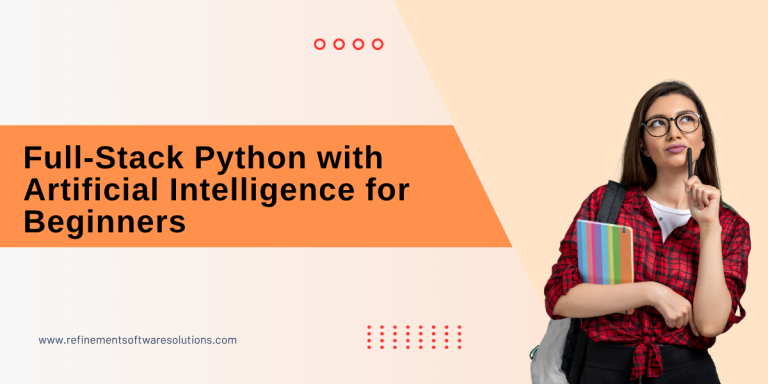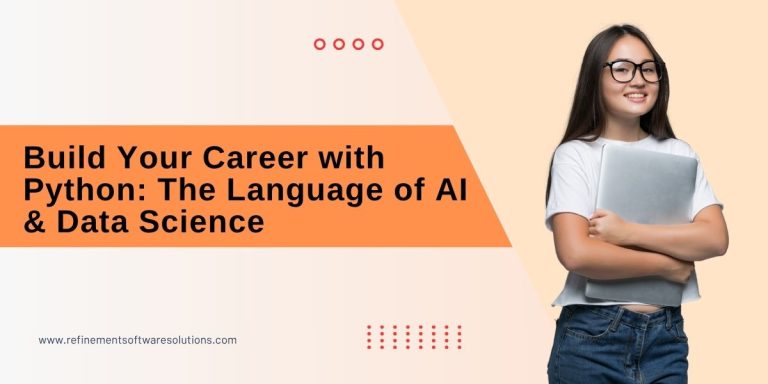Table of Contents
Toggle
Python Full Stack Developers are in high demand due to their expertise in both front-end and back-end technologies. A Full Stack Developer handles the entire development process, from the user interface to the server-side logic and database management. With Python being one of the most popular programming languages, it is an excellent choice for building full-stack applications.
If you’re preparing for an interview as a Python Full Stack Developer in 2025, it’s essential to understand the key concepts and skills that interviewers will assess.
In this article, we’ll explore the top 20 interview questions to help you prepare and succeed in your Python Full Stack Developer interview.
1. What is Full Stack Development, and why is Python a good choice for it?
Answer: Full Stack Development involves both front-end and back-end development. The front end is the part of the application that users interact with, while the back end consists of the server-side logic and database management. Python is a popular choice for Full Stack Development because of its simplicity, extensive libraries, and frameworks like Django and Flask. Python allows developers to efficiently handle both front-end and back-end tasks, making it a versatile language for building scalable and maintainable applications.2. What is the difference between Django and Flask?
Answer: Django and Flask are two popular web frameworks in Python, but they differ in their complexity and use cases:- Django is a high-level framework that follows the “batteries-included” philosophy. It provides everything a developer needs to build a full-fledged web application, such as authentication, admin panel, ORM (Object-Relational Mapping), and more.
- Flask, on the other hand, is a micro-framework that is lightweight and flexible. It provides the bare essentials for web development, allowing developers to choose and integrate third-party libraries based on their requirements.
3. What is RESTful API, and how do you create it in Python?
Answer: A RESTful API (Representational State Transfer) is an architectural style for designing networked applications. It uses HTTP requests to perform CRUD operations (Create, Read, Update, Delete) on resources. To create a RESTful API in Python, you can use frameworks like Flask or Django REST Framework (DRF). For example, using Flask, you can create an API endpoint like this: from flask import Flask, jsonify app = Flask(__name__) @app.route(‘/api’, methods=[‘GET’]) def get_data(): return jsonify({‘message’: ‘Hello, world!’}) if __name__ == ‘__main__’: app.run(debug=True)4. What is MVC architecture, and how is it used in Python?
Answer: MVC (Model-View-Controller) is a software architectural pattern used for developing user interfaces. In Python:- Model represents the data and the business logic of the application.
- View is the user interface (UI) part of the application, which is responsible for displaying the data.
- Controller acts as an intermediary between the Model and the View. It handles user inputs and updates the Model accordingly.
5. How do you handle database migrations in Python?
Answer: Database migrations are handled through tools provided by frameworks like Django and Flask:- Django uses Django Migrations to manage database schema changes. It tracks changes in models and creates migration files to apply to the database.
- Flask uses Flask-Migrate, which is an extension for handling SQLAlchemy database migrations using Alembic.
6. What are some common Python libraries used for front-end development?
Answer: While Python is primarily used for back-end development, it can be used for front-end development as well. Some libraries for front-end development include:- Pyjs: A Python-to-JavaScript compiler that allows writing front-end code in Python.
- Brython: A Python implementation for the browser, allowing developers to write client-side code in Python. However, in most cases, Python developers rely on JavaScript frameworks like React, Angular, or Vue.js for front-end development.
7. What is the importance of Git in Full Stack Development?
Answer: Git is a distributed version control system used to track changes in the source code during software development. It is crucial for collaboration in full-stack development, as multiple developers can work on different parts of the application simultaneously. Git allows developers to manage and merge changes efficiently, ensuring code integrity and version history. Platforms like GitHub and GitLab provide a centralized repository for sharing and collaborating on code.8. What are the different types of database management systems (DBMS)?
Answer: There are two main types of DBMS:- Relational Database Management System (RDBMS): These databases use structured query language (SQL) to store data in tables with rows and columns. Popular RDBMS options include MySQL, PostgreSQL, and SQLite.
- NoSQL Database: These databases are non-relational and store data in various formats such as key-value pairs, documents, or graphs. Popular NoSQL databases include MongoDB, Cassandra, and Redis.
9. How do you implement authentication in Python applications?
Answer: Authentication is a critical part of web applications. In Python applications, authentication is often implemented using:- Django: Django provides built-in authentication features, including login, logout, password hashing, and user registration.
- Flask: Flask uses extensions like Flask-Login for user session management and Flask-Security for authentication and authorization.
10. What are some common security practices in Python web applications?
Answer: Security is a top priority in web development. Some common practices include:- SQL Injection Prevention: Use parameterized queries or ORM frameworks to prevent SQL injection attacks.
- Cross-Site Scripting (XSS): Sanitize user input to prevent the injection of malicious scripts.
- Cross-Site Request Forgery (CSRF): Implement CSRF tokens to protect against malicious requests.
- Password Hashing: Always store passwords in a hashed format using algorithms like bcrypt.
11. What is the purpose of middleware in Django and Flask?
Answer: Middleware is a way to process requests globally before reaching the view or after the response is returned. In Django and Flask, middleware can be used for various purposes, including:- Authentication and authorization
- Session management
- Logging
- Error handling
12. What are the differences between GET and POST requests in HTTP?
Answer:- GET: This HTTP method is used to request data from a server. It is a read-only operation and appends parameters to the URL. GET requests are idempotent, meaning multiple identical requests should produce the same result.
- POST: This HTTP method is used to submit data to the server. It sends data in the body of the request and is used for operations like creating or updating resources. POST requests are not idempotent.
13. How do you perform error handling in Python?
Answer: Error handling in Python is done using the try-except block. For example: try: result = 10 / 0 except ZeroDivisionError as e: print(f”Error occurred: {e}”) Python also supports custom exception classes and multiple exception handling to cater to various error scenarios.14. What is the role of a front-end developer in a Full Stack team?
Answer: A front-end developer in a Full Stack team is responsible for creating the visual aspects of a web application. They work with HTML, CSS, JavaScript, and front-end libraries/frameworks to build the user interface and ensure a seamless user experience. In a Full Stack development environment, the front-end developer collaborates with back-end developers to ensure the front end integrates seamlessly with the server-side functionality.15. What is the difference between synchronous and asynchronous programming in Python?
Answer:- Synchronous Programming: In synchronous programming, tasks are executed sequentially. Each operation waits for the previous one to complete before moving to the next. This can cause delays in performance.
- Asynchronous Programming: Asynchronous programming allows tasks to be executed concurrently. It improves performance by allowing other tasks to run while waiting for operations like file I/O or network requests to complete. Python’s asyncio library helps in implementing asynchronous programming.
16. How do you handle file uploads in Python?
Answer: File uploads in Python can be handled in Django and Flask through their built-in functionality:- Django: Django provides the FileField to manage file uploads in models and handles uploaded files using the MEDIA_ROOT and MEDIA_URL settings.
- Flask: Flask uses the request.files object to handle file uploads.
17. How do you optimize the performance of a Python web application?
Answer: Performance optimization can be done through several techniques, such as:- Database Indexing: Optimize queries by indexing frequently used fields.
- Caching: Use caching mechanisms like Redis or Memcached to store frequently accessed data.
- Code Profiling: Use profiling tools like cProfile to identify performance bottlenecks in your code.
- Asynchronous Processing: Use asynchronous programming and task queues (e.g., Celery) for handling heavy tasks in the background.
18. What is CORS, and how do you handle it in Python web applications?
Answer: CORS (Cross-Origin Resource Sharing) is a security feature that allows or restricts resources to be requested from another domain. In Python web applications, CORS can be handled by enabling the CORS headers on the server-side.- Flask: The Flask-CORS extension allows you to manage CORS in Flask applications.
- Django: The django-cors-headers package is used to handle CORS in Django.
19. How do you handle sessions in Django and Flask?
Answer: Sessions are used to store user-specific information across requests:- Django: Django provides built-in session handling via the django.contrib.sessions framework. Sessions can be stored in the database, cookies, or file system.
- Flask: Flask uses the Flask-Session extension to manage server-side sessions.





